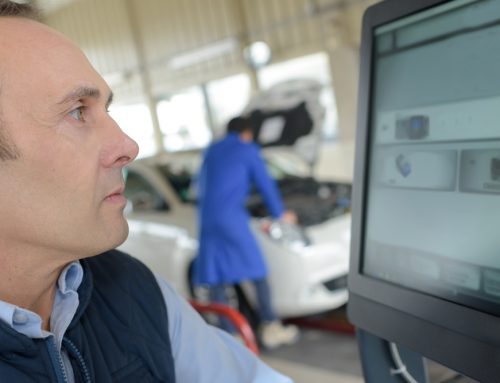Communication, a skill that is too often overlooked in the body shop.
Many times, we wonder how we can perform more, produce more, sell more, or generate more profits. But we rarely think about how we can communicate more. Here, we’re talking about quality, not quantity. It’s all about giving the right information at the right moment and to the right person.
Quantity should not take precedence over quality. The last thing you want to do is to swamp your team with information and slow things down. You must find your sweet spot, what makes your team efficient and motivated.
Communication is a skill that is often overlooked because it is not immediately as tangible as a painter achieving a good blend on a vehicle. Still, it is not a skill to be ignored, far from it.
At Progi, we consider it to be the second most important element in the recipe for collision shop performance. Investing in it properly will improve your key performance indicator results.
You don’t have to be Barack Obama to get into communications. All efforts are welcome. If you feel inadequate and alone in this challenge, you can enlist the help of either a consultant or a manager with a strong affinity for this skill to give you some structure and coaching.
Note that if you do not take the time to communicate with everyone, either by yourself or through a production supervisor, your team members will not take the time to communicate with you or your management team members because they think you are inaccessible. You can miss on important innovation-related ideas, for example. If employees can’t communicate or get involved, they generally feel less committed to the team and its success.
Investing time to communicate will have the following effects on your team:
- Better repair coordination.
- Better adaptation to change.
- Better team mobilization.
- Achieving better monetary and operational performance.
What to Communicate?
- The shop’s objectives.
- Changes and their reasons (e.g.: tools, processes, objectives).
- The vehicle’s repair status.
- Issues and related solutions, both day-to-day and long-term.
How to Communicate?
We live in a time when 1) employees are rare, and 2) they like to feel involved in the success of the company. We are moving away from the Industrial Revolution legacy of employee-management communication towards a flexible, inviting and participatory tone. The era of taking employees for granted is over.
Entrepreneurs and their managers must develop an important skill: leadership. It’s not only about giving the right information at the right moment and to the right person, but it is also about using the right tone to help employees embrace change, commit to the company’s success and goals and mobilize the troops to generate loyalty towards your organization.
We want to create a positive culture in our company where success and performance play key roles.
What are the Tools for Successful Communications?
From an intangible perspective, meetings are important tools. Below are examples of daily, weekly and individual meetings, but they only serve as guides. The only rules: be relevant, positive and goal oriented.
Since I am writing this text during the hockey series, I will use a hockey-related example. It’s not important to have lost the first two periods if we make adjustments and stay positive, it will allow us to win in the third period. Our attitude towards adversity should not ruin the troops’ morale.
Morning Meeting (5 to 15 minutes maximum)
Objectives: Optimize repairs and make sure that the repair process runs smoothly.
Who: Assistant, floor manager, part manager, general management/owner, depending on their involvement.
Topic examples:
- Identify bottlenecks and blockers for ongoing and upcoming repairs: missing parts and supplements, broken equipment, late subcontractors, absent teammates and determine a game plan to solve them;
- Vehicles that will be delivered and dropped off during the day;
- Review of the week’s goals.
Tip: Do your daily meetings standing up. It saves time and energy.
Weekly Meeting (30 minutes)
Objectives: Team building and information. Feel free to have special themes.
Who: The team.
Topic examples:
- A review of the training your technicians are taking;
- Acknowledgements;
- Addressing projects that have not gone well and discussions on how to improve;
- Explain upcoming changes, e.g.: new processes in the shop, goals, new requirements from a client or a banner, if any.
Charles’s advice: Plan your meeting on a Wednesday. Why? Because the team is already halfway to achieving its weekly goals. It’s not too late to mobilize and turn a bad start into a success.
Individual Meeting
Objectives: Divide and conquer. Does this phrase ring a bell? You have goals for our shop, and to make the team accountable you need to inform each person of their role and objectives, of the blockages and solutions to reach these goals.
This meeting will keep your workforce on their toes. It’s a bit like when the coach comes to see our monthly progress at the gym. We put a lot more effort into it than if no one came to see us. Coaching is very stimulating for the human psyche.
Don’t wait until the end of the year to evaluate your technicians. Meet them on a regular basis (at least every three months) to go over their objectives, talk about their strengths and weaknesses and give them a more official pat on the back. You can meet more or less frequently, depending on the individuals and their needs to:
- Target expectations;
- Coach;
- Explain some of the changes to the more reluctant;
- Evaluate and give feedback.
Communication Tool
Communicating obviously doesn’t mean to talk all day long. There are tools that can help us communicate and collaborate with our team to share the right information at the right moment.
For example, a simple television strategically placed in the workshop to project ProgiPlanning is a great help and it’s easy to set up.
What should these tools communicate in the shop?
- The vehicles repair status and the work progress.
- The progression of your goals.
In conclusion, the team is the collision shop’s corner stone. No team, no repairs. Communication is the oil in the workings of a collision shop, allowing it to operate at its full potential.
Author: Alexandre Rocheleau
Collaboration: Charles Aubry
Translation: Sophie Larocque
Editing: Émilie Blanchette
Review Rule No. 1 in this series: Number 1 Performance Rule for Collision Shop Manager: Setting Objectives.





